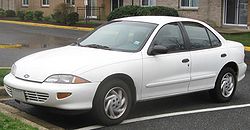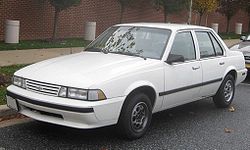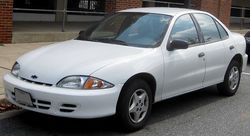- Chevrolet Cavalier
-
Not to be confused with Vauxhall Cavalier or AMC Cavalier.
Chevrolet Cavalier 
Manufacturer General Motors Production 1982–2005 Predecessor Chevrolet Monza Successor Chevrolet Cobalt (For United States and Canada)
Chevrolet Optra (For Mexico)Class Compact Layout FF layout Platform J-body The Chevrolet Cavalier is a compact automobile produced from 1982 to 2005 by General Motors. Built on the company's J platform, the Cavalier was one of the best-selling cars in the United States throughout its life.[citation needed]
Contents
Predecessors
The Cavalier replaced the Monza, which was available as a 2-door coupe, a 3-door hatchback and a 3-door wagon (using the same body as the discontinued Vega wagon, the model it replaced). The inexpensive Chevette was retained even as sales declined, and was formally replaced by even smaller captive imports. Both previous platforms had rear-drive layouts while the new design followed the front wheel drive trend, as in the Dodge Omni and Honda Civic. Ford and Chrysler also introduced new front drive compacts. The largely successful mission of capturing the bulk of domestic compact sales would fall on the Cavalier's 2-door coupe, 4-door sedan and 4-door station wagon, the relatively short-lived 3-door hatchback (which replaced the Monza 2+2 Sport 2-door hatchback) and, in later years, a 2-door convertible. The small Cavalier even helped fill in lagging sales of the compact Citation (a Nova replacement).
First generation
First generation 
Model years 1982–1987 Assembly Lordstown, Ohio, United States
Lansing, Michigan, United States
Janesville, Wisconsin, United States
Ramos Arizpe, Coahuila, Mexico
South Gate, California, United States (1982 only)
Kansas City, Missouri, United StatesBody style 2-door convertible
2-door sedan
3-door hatchback
4-door sedan
4-door station wagonEngine 1.8 L 122 I4
2.0 L 122 I4
2.8 L 60-degree V6Transmission 4-speed manual
5-speed manual
3-speed automaticWheelbase 101.2 in (2,570 mm) Length Sedan: 174.5 in (4,432 mm)
Coupe: 173.5 in (4,407 mm)
Wagon: 177.9 in (4,519 mm)Width Sedan & Coupe: 66.0 in (1,676 mm)
Wagon: 66.3 in (1,684 mm)Height Sedan & Coupe: 52.0 in (1,321 mm)
Wagon: 54.2 in (1,377 mm)Related Buick Skyhawk
Cadillac Cimarron
Oldsmobile Firenza
Pontiac Sunbird
Vauxhall Cavalier
Isuzu Aska
Holden CamiraThe Cavalier first went on sale in early 1981 as a 1982 model with front-wheel-drive, a choice of two carbureted four-cylinder pushrod engines, and 2 and 4-door sedan, hatchback, and station wagon body styles. Convertibles were added in 1983, initial production totaling less than 1000.
1983 Cavaliers offered throttle body fuel injection, and a V6 engine became available in 1985, uncommon for a subcompact car. The 1984 models received a mild facelift featuring quad headlights.
The Cavalier was largely identical to the Pontiac Sunbird. Before the Pontiac brand was officially introduced in Mexico in 1992, Cavaliers sold there featured Sunbird body panels, as opposed to US-spec Cavalier panels. From 1993 on, the sibling marques were both offered, as in the United States.
Second generation
Second generation 
Model years 1988–1994 Assembly Lordstown, Ohio, United States
Lansing, Michigan, United States
Ramos Arizpe, Coahuila, MexicoBody style 2-door convertible
2-door coupe
4-door sedan
4-door station wagonEngine 2.0 L 122 I4
2.2 L 122 I4
2.8 L 60-degree V6
3.1 L 60-degree V6Transmission 5-speed manual
3-speed automaticWheelbase 1988–89: 101.2 in (2,570 mm)
1990–94: 101.3 in (2,573 mm)Length 1988–89: 178.6 in (4,536 mm)
1988–89 Wagon: 178.8 in (4,542 mm)
1990–94: 182.3 in (4,630 mm)
1990–94 Wagon: 181.1 in (4,600 mm)Width 66.3 in (1,684 mm)
1988–89 Sedan/Coupe/Wagon: 66.0 in (1,676 mm)Height 1988–1991 Coupe & 1990–91 Convertible: 52.0 in (1,321 mm)
1988–1991 Sedan: 53.6 in (1,361 mm)
1988–89 & 1992–94 Convertible: 52.2 in (1,326 mm)
1988–89 Wagon: 54.3 in (1,379 mm)
1990–91 Wagon: 54.1 in (1,374 mm)
1992–94 Wagon: 53.8 in (1,367 mm)
1992–94 Coupe: 51.9 in (1,318 mm)
1992–94 Sedan: 53.5 in (1,359 mm)Curb weight 2,359 lb (1,070 kg) (coupe)
2,363 lb (1,072 kg) (sedan)
2,271 lb (1,030 kg) (RS coupe)
2,414 lb (1,095 kg) (RS sedan)
2,558 lb (1,160 kg) (Z24 coupe)
2,665 lb (1,209 kg) (Z24 convertible)Related Buick Skyhawk
Cadillac Cimarron
Oldsmobile Firenza
Pontiac Sunbird
Vauxhall CavalierThe Cavalier was restyled in 1988. The two door hatchback was dropped, while the coupe, sedan, wagon and convertible carried over. The sedan and wagon were unchanged from the doors back, while the coupe's exterior was completely redesigned. This resulted in different trunk designs for the coupe and sedan. Three trim levels were available in 1988: VL, RS, and Z24. The convertible was only available as a Z24. The VL and RS came standard with the 2.0 L L4 engine producing 90 hp (67 kW), while the 2.8 L V6 producing 125 hp (93 kW) was optional on the RS and standard on the Z24.[1] With all trims, 5-speed manual transmission was standard, and a 3-speed automatic was optional. An electronic dashboard was available with the RS and Z24 trims.
In 1989, the steering column was redesigned to be adjustable, as well as the addition of 3-point seat belts for the rear outboard seats. The optional V6 was retooled to 130 hp.[2]
In 1990, the base engine was enlarged to a 2.2 L L4, and power increased to 95 horsepower (71 kW). The optional V6 engine was also upgraded to the 3.1 L V6 and 140 horsepower.[3] The convertible was dropped from availability to prevent internal competition with a planned Beretta convertible. However, the Beretta convertible was shelved at the eleventh hour, before a 1990 Cavalier convertible could be prepared.
The Cavalier got a more extensive restyling in 1991 that involved a new hood, bumpers, headlights, taillights, wheel covers and a redesigned interior. Most notably, the cooling system was redesigned to draw air from the bumper, giving it a Ford Taurus-style bumper and grille-less nose. The new bumpers were unpainted, with the option to have them colored grey, black or white; the latter only available on white-colored models. The Z24 eschewed this for a color keyed body kit. Z24 models also gained the options for a height adjustable driver's seat and a CD player. The platform and trim lines were carried over, while the convertible was brought back mid-year in the RS trim only with the V6 standard.[4]
In 1992, the 2.2 L standard engine adopted multi-point fuel injection to improve output to 110 horsepower (82 kW).[5] The convertible was now available in both RS and Z24 trims, with the V6 standard in the Z24 and optional with the RS. Antilock brakes were added as a standard feature, as Delco Moraine had managed to develop a low-cost system. Power locks were also standard, and were designed to automatically lock when the car is shifted out of park, or if the car is traveling at least 8 miles per hour in manual transmission equipped models.
1993 brought minimal changes to the Cavalier line. The convertibles receive a glass rear window, allowing rear window defrost as an option.[6]
1994 models were also carryovers, as a new model of Cavalier was in development. The VL trim was dropped on the wagon, while the 2.2 L OHV L4's fuel delivery was improved to sequential fuel injection, increasing its output to 120 horsepower.[7] Additional changes included a slightly redesigned climate control interface and the power locking system being again redesigned: the doors would still lock automatically when put into gear, but they would also unlock automatically when the ignition was switched off.
Third generation
Third generation 
Also called Toyota Cavalier (Japan) Model years 1995–2005 Assembly Lordstown, Ohio, United States
Lansing, Michigan, United States
Ramos Arizpe, Coahuila, MexicoBody style 2-door convertible
2-door coupe
4-door sedanEngine 2.2 L 122 (2200) I4
2.2 L Ecotec I4
2.3 L Quad 4 (LD2) I4
2.4 L Twin Cam (LD9) I4Transmission 5-speed Getrag F23 manual
5-speed Getrag 282 manual
5-speed Isuzu manual
4-speed automatic (GM 4T40E)
3-speed automatic (GM 3T40)Wheelbase 104.1 in (2,644 mm) Length 1995–97: 180.3 in (4,580 mm)
1998–2002: 180.7 in (4,590 mm)
2003–05: 180.9 in (4,595 mm)Width 2-Door: 68.7 in (1,745 mm)
4-Door: 67.9 in (1,725 mm)Height 1995–97 Coupe: 53.2 in (1,351 mm)
1995–97 Sedan: 54.8 in (1,392 mm)
1995–97 Convertible: 53.9 in (1,369 mm)
1998–2005 Coupe: 53.0 in (1,346 mm)
1998–99 Convertible: 54.1 in (1,374 mm)
1998–2005 Sedan: 54.7 in (1,389 mm)
2000–02 Convertible: 53.7 in (1,364 mm)Curb weight 2,562 lb (1,162 kg) - 2,784 lb (1,263 kg)
Z24 2,749 lb (1,247 kg)Related Pontiac Sunfire The Cavalier received its first total redesign in 1995, with expanded dimensions and more modern looks. Some of the basic styling cues remained however, such as the coupes' dipped beltline. The wagon was discontinued, but the coupe, sedan, and convertible body styles returned. This Chevrolet Cavalier generation lost the V6 engine entirely. It is the only Chevrolet Cavalier generation that did not offer a V6 option, all were four-cylinder.
The Cavalier Z24 received a new engine in 1996, the LD9 2.4 liter engine. This engine cranked out 150 hp (112 kW) and 155 lb·ft (210 N·m) of torque and was used until 2002. In 1999, the car lost the "CHEVROLET" text badge at the trunklid. This engine came mated standard with the Getrag F23 5-speed manual transmission. The Z24 only came in 2-door coupe models up until 2000 and featured a sport-tuned suspension, 16-inch tires and alloy wheels and improved interior electronics. Aesthetically inside and out little changed from the other models other than a ground effects kit and taller rear spoiler. In 2000 a 4-door Z24 Sedan debuted, featuring the same mechanics but having a less sporty body. The Z24 Trim also received several other upgrades including a wider front sway bar and FE2 Sports Suspension for better handling characteristics, and less aggressive ABS anti-lock braking system. In 2003 the Cavalier Z24 line was dropped and replaced by the LS Sport line, which featured the new Ecotec L61 motors (140 hp (104 kW) and 150 lb·ft (200 N·m) torque). These engines improved fuel economy, featuring a smaller engine, while maintaining the power of the now-outdated LD9 motors. These motors remained in the Cavaliers up until 2005 when the Chevrolet Cavalier was replaced by the Chevrolet Cobalt.
A GM Eaton M45 Supercharger kit was also offered for the Z24 trim as well. The supercharger kit was developed and tested by General Motors and could only be installed at a GM dealer. This upgrade drastically increased performance due to a pressure of 4.7 PSI which in turn added approximately 40 hp (30 kW) and 40 lb·ft (54 N·m) of torque increase; raising the Z24's ratings to approximately 190 hp (142 kW) and 195 lb·ft (264 N·m) of torque.
The Cavalier was facelifted in 2000 and in 2003. The convertible was discontinued after 2000.
Toyota Cavalier
- This article incorporates information from the equivalent article on the Japanese Wikipedia.
 1998 Toyota Cavalier coupé (Japanese export model with amber rear turn signals, right hand drive and flecked red/grey interior)
1998 Toyota Cavalier coupé (Japanese export model with amber rear turn signals, right hand drive and flecked red/grey interior)
As part of a wider effort to avoid additional restrictions on exports to the US, the third generation model was briefly sold in Japan by Toyota under an agreement with GM, badged as the Toyota Cavalier as in return for the Geo/Chevrolet Prizm. Aside from the fact that it was right hand drive, the Toyota Cavalier also featured a leather-wrapped shift knob and steering wheel, wider front fenders, amber turn signals for Japanese regulations, power folding side mirrors, side turn signal repeater lights on the front fenders, and carpeting on the inside of the trunk lid. Interior seats were often flecked with color, and the rear seat had a fold-down armrest. Vehicles produced between February through December 1998 were available with a leather interior equipped with an automatic transmission only. All models featured wheels borrowed from the Pontiac Sunfire. The Toyota Cavalier was available in 2.4G and 2.4Z trim levels. While all Chevrolet-badged Cavaliers received a facelift for 2000, the Toyota did as well with the updated center console, head-lights/hood/front bumper, tail-lights, and colors available. TRD made a body kit and rear wing for the Cavalier, available exclusively in Japan.
The Toyota Cavalier was entirely produced by GM in the USA and sold from 1995–2000. 1996-2000 Toyota Cavaliers came equipped with the 2.4 L LD9 engine, while the 1995 used the 2.3 L Quad 4. Due to the engine displacement and width dimensions (1,740 mm (69 in) for the coupe, 1,735 mm (68 in) for the sedan ) exceeding Japanese government regulations concerning exterior dimensions and maximum engine displacement, it was not considered a "compact" and incurred an additional yearly tax, which had an effect on sales. Prices for the coupe started at ¥ 2 million yen for the coupe, and ¥ 1,81 million yen for the sedan.
Due to higher than typically average Motor-vehicle inspection (Japan) costs, a fair number of these vehicles are re-exported as Japanese used cars, most notably to Australia and New Zealand. Production of the Toyota Cavalier ceased in June 2000. Despite the fact that Toyota made great attempts to market the Cavalier to Japanese buyers, the Japanese public was not impressed with the quality of workmanship, typically expected of cars sold in Japan.[8]
Safety
The third-generation Cavalier earned several low scores in crash tests by the Insurance Institute for Highway Safety and National Highway Traffic Safety Administration. Also, IIHS fatality risks statistics rated the Cavalier among the "Highest rates of driver deaths," with 150 (4 door) to 171 (2 door) driver deaths per million registered vehicle years. Average for the Cavalier class (small) was 103 (4 door) to 134 (2 door) driver deaths per million registered vehicle years.[9]
The IIHS gave the 1995-2005 Cavalier a "Poor" overall score in their frontal offset collision test.[10]
2005 National Highway Traffic Safety Administration (NHTSA) Crash Test Ratings (coupe):[11]
2002 National Highway Traffic Safety Administration (NHTSA) Crash Test Ratings (sedan):[12]
Production
Most Cavaliers were built at Lordstown Assembly, although they have also been produced in South Gate, California (1982 model year only), Lansing Car Assembly (1996-1998 coupes), Lansing Craft Centre (1996-2000 convertibles), Janesville Assembly, Ramos Arizpe, and Leeds Assembly.
Production ended on October 6, 2004
United States sales figures
- 58,904 - 1982
- 268,587 - 1983
- 462,611 - 1984
- 383,752 - 1985
- 432,101 - 1986
- 346,254 - 1987
- 322,939 - 1988
- 376,626 - 1989
- 310,501 - 1990
- 326,847 - 1991
- 225,633 - 1992
- 251,590 - 1993
- 254,426 - 1994
- 151,669 - 1995
- 261,686 - 1996
- 315,136 - 1997
- 238,861 - 1998
Sources: Edmunds.com (1992–98), Autoworld.com (1999 estimate)[13]
Engines used
- 1982 — 1.8 L OHV 2-barrel inline-4, 88 horsepower
- mid 1982–1984 — 2.0 L OHV 2-barrel inline-4, 90 horsepower
- 1983–1989 — 2.0 L OHV TBI inline-4, 86 horsepower (1983–1984), 88 horsepower (1985–1986), 90 horsepower (1987–89)
- 1985–1989 — 2.8 L OHV MPFI V6, 120-130 horsepower (125 in 1985, 120 in 1986, 130 in 1987, 125 in 1988, and 130 in 1989)
- 1990–1994 — 2.8 L OHV MPFI V6, 130 horsepower (Mexico and Venezuela only, *Colombia used a version of 116 hp.
Magazine Motor El Tiempo, http://www.carrosyclasicos.com/a.php?a=864 (Information in spanish language).
- 1990–1991 — 2.2 L OHV TBI inline-4, 95 horsepower (71 kW)
- 1990–1994 — 3.1 L OHV MPFI V6, 140 horsepower (100 kW)
- 1992–2002 — 2.2 L OHV MPFI L4, 110 horsepower (1992–93), 120 horsepower (1994–97, 1994 upgrade to SFI), 115 horsepower (1998–2002)
- 1995 — 2.3 L DOHC MPFI Quad 4, 150 horsepower (110 kW)
- 1996–2002 — 2.4 L DOHC SFI L4, 150 horsepower (110 kW)
- 2002–2005 — 2.2 L DOHC Ecotec SFI L4, 140 horsepower (100 kW)
References
- ^ "''autos.msn - 1988 Chevrolet Cavalier''". Autos.msn.com. 2010-02-22. http://autos.msn.com/research/vip/Spec_Glance.aspx?year=1988&make=Chevrolet&model=Cavalier. Retrieved 2010-10-05.
- ^ by the Auto Editors of Consumer Guide (2007-08-04). "''howstuffworks.com - 1989 Chevrolet Cavalier''". Auto.howstuffworks.com. http://auto.howstuffworks.com/chevrolet-cavalier8.htm. Retrieved 2010-10-05.
- ^ "''autos.msn - 1990 Chevrolet Cavalier''". Autos.msn.com. 2010-02-22. http://autos.msn.com/research/vip/Spec_Glance.aspx?year=1990&make=Chevrolet&model=Cavalier. Retrieved 2010-10-05.
- ^ "Chevy Cavalier History''". Conceptcarz.com. http://www.conceptcarz.com/vehicle/z12095/Chevrolet-Cavalier.aspx. Retrieved 2010-10-05.
- ^ "''autos.msn - 1992 Chevrolet Cavalier''". Autos.msn.com. 2010-02-22. http://autos.msn.com/research/vip/Spec_Glance.aspx?year=1992&make=Chevrolet&model=Cavalier. Retrieved 2010-10-05.
- ^ by the Auto Editors of Consumer Guide (2007-08-04). "''howstuffworks.com - 1993 Chevrolet Cavalier''". Auto.howstuffworks.com. http://auto.howstuffworks.com/chevrolet-cavalier12.htm. Retrieved 2010-10-05.
- ^ "''autos.msn - 1994 Chevrolet Cavalier''". Autos.msn.com. 2010-02-22. http://autos.msn.com/research/vip/Spec_Glance.aspx?year=1994&make=Chevrolet&model=Cavalier. Retrieved 2010-10-05.
- ^ http://www.thetruthaboutcars.com/2010/01/the-toyota-cavalier-and-the-truth-about-japanese-import-barriers/
- ^ "Status Report, Vol. 42, No. 4, April 19, 2007" (PDF). http://www.iihs.org/sr/pdfs/sr4204.pdf. Retrieved 2010-10-05.
- ^ "IIHS-HLDI: Chevrolet Cavalier". Iihs.org. 2005-09-29. http://www.iihs.org/ratings/rating.aspx?id=45. Retrieved 2010-05-13.
- ^ "Safercar.gov". Safercar.gov. http://www.safercar.gov/portal/search?model=3230. Retrieved 2010-05-13.[dead link]
- ^ "Safercar.gov". Safercar.gov. http://www.safercar.gov/portal/search?model=3231. Retrieved 2010-05-13.[dead link]
- ^ http://www.autoworld.com/apps/news/FullStory.asp?id=335
External links
- Toyota Cavalier (Japanese)
- Chevrolet Cavalier Review - Funcheapcars.com
- The J-Body Organization
- The J-Body Source (How-tos/Modification Guides)
- Z24 V6 Enthusiast Site
- ClubCav
- JCO - J-body Club of Ontario
- Russian Toyota/Cavalier fans
« previous – Chevrolet, a division of General Motors, road car timeline, United States market, 1980s–present Type 1980s 1990s 2000s 2010s 0 1 2 3 4 5 6 7 8 9 0 1 2 3 4 5 6 7 8 9 0 1 2 3 4 5 6 7 8 9 0 1 2 Subcompact Sprint Geo Metro Chevette Aveo Sonic Spectrum Monza Nova Compact Prizm Volt Cavalier Cavalier Cavalier HHR Citation Cobalt Cruze Mid-size Malibu Corsica / Beretta Malibu Malibu Malibu Celebrity Lumina Lumina Full-size Impala Impala SS Impala Impala Caprice Caprice Caprice Personal Monte Carlo Monte Carlo Monte Carlo Monte Carlo Sports Camaro Camaro Camaro Camaro Corvette Corvette Corvette Corvette Categories:- Chevrolet vehicles
- Compact cars
- Convertibles
- Coupes
- Front wheel drive vehicles
- Hatchbacks
- Sedans
- Station wagons
- 1980s automobiles
- 1990s automobiles
- 2000s automobiles
- Vehicles built in Lansing, Michigan
- Vehicles introduced in 1982
- Motor vehicles manufactured in the United States
Wikimedia Foundation. 2010.












